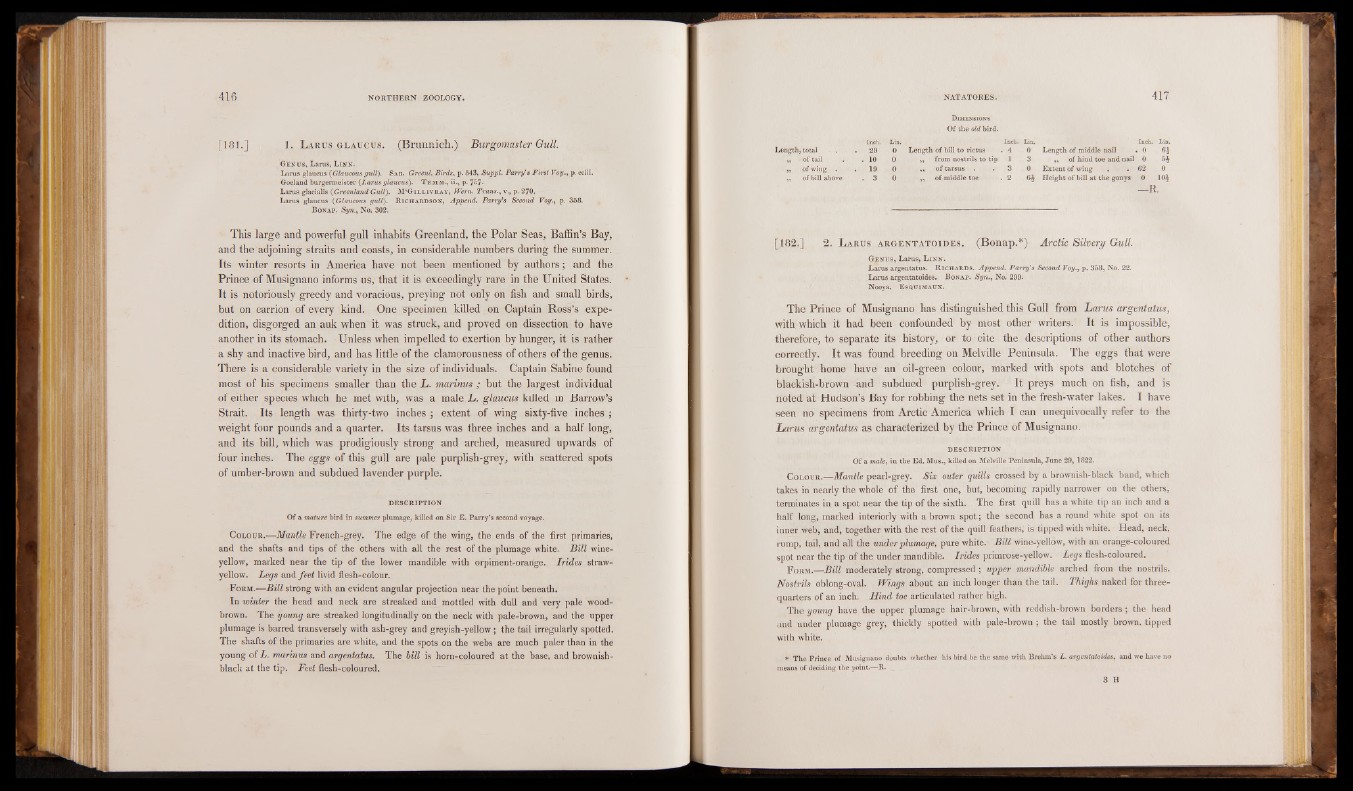
181.] 1. L a r u s g l a u c u s . (Brunnich.) Burgomaster Oull.
Ge n u s , Laras, L in n .
Larus glaucus (Glaucous gull). Sab. Greenl. Birds, p. 543, Suppl. Parry's First Voy., p. cciii.
Goeland burgermeister (Larus glaucus). Temm., ii., p. 757-
Lams glacialis (Greenland Gull). M‘G il l iv r a y , Wern. Trans., v., p. 270.
Lams glaucus (Glaucous gull). R ic ha rdso n , Append. Parry’s Second Voy., p. 358.
B onap. Syn., No. 302.
This large and powerful gull inhabits Greenland, the Polar Seas, Baffin’s Bay,
and the adjoining straits and coasts, in considerable numbers during the summer.
Its winter resorts in America have not been mentioned by authors; and the
Prince of Musignano informs us, that it is exceedingly rare in the United States.
It is notoriously greedy and voracious, preying not only on fish and small birds,
but on carrion of every kind. One specimen killed on Captain Ross’s expedition,
disgorged an auk when it was struck, and proved on dissection to have
another in its stomach. Unless when impelled to exertion by hunger, it is rather
a shy and inactive bird, and has little of the clamorousness of others of the genus.
There is a considerable variety in the size of individuals. Captain Sabine found
most of his specimens smaller than the L . marinus ; but the largest individual
of either species which he met with, was a male L . glaucus killed in Barrow’s
Strait. Its length was thirty-two inches ; extent of wing sixty-five inches ;
weight four pounds and a quarter. Its tarsus was three inches and a half long,
and its bill, which was prodigiously strong and arched, measured upwards of
four inches. The eggs of this gull are pale purplish-grey, with scattered spots
of umber-brown and subdued lavender purple.
DESCRIPTION
Of a mature bird in summer plumage, killed on Sir E. Parry’s second voyage.
Colour.—Mantle French-grey. The edge of the wing, the ends of the first primaries,
and the shafts and tips of the others with all the rest of the plumage white. Bill wine-
yellow, marked near the tip of the lower mandible with orpiment-orange. Irides straw-
yellow. Legs and feet livid flesh-colour.
Form.—Bill strong with an evident angular projection near the point beneath.
In winter the head and neck are streaked and mottled with dull and very pale wood-
brown. The young are streaked longitudinally on the neck with pale-brown, and the upper
plumage is barred transversely with ash-grey and greyish-yellow ; the tail irregularly spotted.
The shafts of the primaries are white, and the spots on the webs are much paler than in the
young of L. marinus and argentatus. The bill is horn-coloured at the base, and brownish-
black at the tip. Feet flesh-coloured.
Dimensions
Of the old bird.
Inch. Lin. Inch. Lin. Inch. Lin.
Length, total . 29 0 Length of bill to rictus . 4 0 Length of middle nail . 0 6 §
' „ of tail . . 10 0 ,, from nostrils to tip 1 3 „ of hind toe and nail 0 5*
,, of-wing . . 19 0 ,, of tarsus . 3 0 Extent of wing . . 62 0
„ of bill above . 3 0 - „ of middle toe . 2 6i Height of bill at the gonys o m
— R.
[182.] 2. L arus a r g e n t a t o id e s . (Bonap.*) Arctic Silvery Oull.
G^e n u s, Larus, L in n .
Larus argentatus. R ic h a r d s . Append. Parry's Second Voy., p. 358, No. 22.
Larus argentatoides. B onap. Syn., No. 299.
Nooya. E sq uim a ux .
The Prince of Musignano has distinguished this Gull from Larus argentatus,
with which it had been confounded by most other writers. It is impossible,
therefore, to separate its history, or to cite the descriptions of other authors
correctly. It was found breeding on Melville Peninsula. The eggs that were
brought home have an oil-green colour, marked with spots and blotches of
blackish-brown and subdued purplish-grey. It preys much on fish, and is
noted at Hudson’s Bay for robbing the nets set in the fresh-water lakes. I have
seen no specimens from Arctic America which I can unequivocally refer to the
Larus argentatus as characterized by the Prince of Musignano.
DESCRIPTION.
Of a male, in the Ed. Mus., killed on Melville Peninsula, June 29, 1822.
Colour.—Mantle pearl-grey. Six outer quills crossed by a brownish-black band, which
takes in nearly the whole of the first one, but, becoming rapidly narrower on the others,
terminates in a spot near the tip of the sixth. The first quill has a white tip an inch and a
half long, marked interiorly with a brown spot; the second has a round white spot on its
inner web, and, together with the rest of the quill feathers, is tipped with white. Head, neck,
rump, tail, and all the under plumage, pure white. Bill wine-yellow, with an orange-coloured
spot near the tip of the under mandible. Irides primrose-yellow. Legs flesh-coloured.
Form.—Bill moderately strong, compressed ; upper mandible arched from the nostrils.
Nostrils oblong-oval. Wings about an inch longer than the tail. Thighs naked for three-
quarters of an inch. Hind toe articulated rather high.
The young have the upper plumage hair-brown, with reddish-brown borders; the head
and under plumage grey, thickly spotted with pale-brown ; the tail mostly brown, tipped
with white.
* The Prince of Musignano doubts whether his bird be the same with Brehm's L. argentatoides, and we have no
means of deciding the point.—R.
3 H